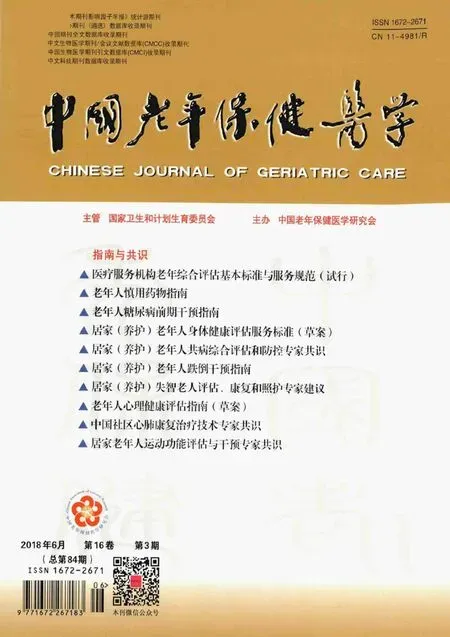经颅直流电刺激在卒中后抑郁中的研究进展
李泓钰 宋鲁平,2,3※
卒中后抑郁(post-stroke depression,PSD)是指发生于卒中后,表现为一系列抑郁症状和相应躯体症状的综合征,以情绪低落、兴趣缺失为主要特征[1]。PSD是卒中后常见的并发症,一项涉及25,488名患者的meta分析显示,卒中后5年内PSD的发生率为31%[2]。PSD的危险因素包括基因、年龄、性别、医疗和精神病史、卒中的类型和严重程度、损伤部位、残疾的等级和社会支持等[3]。患者回归社会的能力与抑郁状态和程度密切相关,PSD不仅会增加患者的认知功能损害,影响康复预后以及生活质量,还会导致死亡率升高[4]。临床上应综合运用心理治疗、药物治疗和康复训练等多种治疗手段,以期达到最佳的治疗效果[1]。目前PSD的治疗以药物与心理治疗为主,但药物不良反应常见而心理治疗周期长。一项Meta分析表明,在PSD患者中抗抑郁药物疗效仅略优于安慰剂[5]。因此寻求一种新的非药物治疗方式具有重要的临床意义。近些年来,经颅直流电刺激(transcranial direct current stimulation,tDCS)作为一种安全、经济、无痛苦、无侵害性、简便易行的技术,越来越多的应用于科研及临床治疗。
1.tDCS简介
tDCS作为治疗PSD的新方法,是一种非侵入性的大脑刺激技术,通过两个头皮电极(阴极与阳极)覆盖靶向治疗皮层区域,应用微弱直流电(0.5~2mA)改变皮层组织兴奋性。目前关于tDCS的研究显示,在治疗情绪障碍[6]、卒中后运动和认知功能障碍等方面都有显著的疗效[7,8]。
1.1 基本原理 tDCS技术改变神经元静息膜电位,以促进(阳极)或抑制(阴极)神经元放电频率[9],改变大脑表面神经元膜电位的去极化或超极化方向,从而起到增强或抑制局部脑区功能的作用,阳极tDCS(Anodal-tDCS,A-tDCS)可使皮质神经元去极化导致皮质兴奋性升高,而阴极tDCS(Cathodal-tDCS,C-tDCS)则使皮质神经元超极化导致皮质兴奋性降低[10]。tDCS刺激足够时间后停止刺激,此效应会持续长达1小时[11]。轴突定向性可以确定直流电(direct current,DC)区域是兴奋性或抑制性的[12]。与高频重复经颅磁刺激(repetitive transcranial magnetic stimulation,rTMS)诱发动作电位而促使神经元活动不同,tDCS不会直接诱发动作电位,而是增加动作电位的可能性[13,14]。谷氨酸能神经元的钙依赖突触可塑性被认为在tDCS作用的神经可塑性机制方面扮演了重要的角色,因为NMDA(N-methyl-D-aspartic acid)受体的阻塞减少了tDCS的作用。此外,tDCS可以局部的减少γ-氨基丁酸(γ-aminobutyric acid,GABA)神经传递,不论刺激的极性[15]。由于这两种神经递质之间的紧密关系可能会影响谷氨酸能可塑性。几乎所有的组织和细胞对电场都很敏感, tDCS可能引起脑内非神经元组织的变化,包括内皮细胞、淋巴细胞或胶质细胞。DC区域可以增强轴突再生以及突起生长,因此有可以促进功能恢复的假说[16]。
1.2 参数选择 一般电极片作用部位依据疾病不同而变化。主要的方案为:①通过A-tDCS上调大脑皮层活性;②通过C-tDCS下调大脑皮层活性;③A-tDCS激活的同时应用C-tDCS抑制[7]。公认应用于人的刺激电流应小于2mA,但多采用1mA甚至更小,对于tDCS刺激时间目前也没有严格的限制,一般20分钟被认为是最佳刺激时间[17,18],治疗疗程大多是10~30次[11,17~19]。在一项涉及259例抑郁患者的Meta分析中发现,与接受≤10次tDCS治疗相比,接受>10次的tDCS治疗有改善更好的趋势,更强的电流也有与更好的抗抑郁效果相关的趋势[6]。tDCS的作用可能依赖于刺激靶向区域、它的投射区域、静息态周围结构、递质系统的病理变化、患者服用的药物[20]以及个体基因多态性[21]之间的复杂空间关系。刺激参数,例如强度[22]、时间及疗程[23]的重要影响。增加tDCS的强度可能会导致兴奋性变化方向的转换,强度增加时引起的电场扩展到达更深层的大脑区域,会改变神经网络环路的性质,造成不可预测的生物和临床作用。因此将来治疗应个体化。
2.研究现状
目前tDCS在卒中后抑郁中的研究相对较少。2011年Viviane F.Bueno等人在个案报导中,应用tDCS(2mA,30分钟)配合氟西汀连续治疗10天,tDCS阳极置于左侧背外侧前额叶(dorsolateral prefrontal cortex,DLPFC),阴极置于右侧眶额部,结果患者抑郁症状得到显著改善,具体量表评分变化见表1[24]。2016年Leandro Valiengo等人进行了开放式病例系列报导,对4名卒中后失语伴有抑郁的患者进行tDCS(2mA,30分钟)治疗,阳极置于左侧DLPFC,阴极置于右侧DLPFC,连续进行10天治疗后,再于2周、4周之后各做1次,共12次,结果所有患者都表现出抑郁症状的改善,失语抑郁量表(aphasic depression rating scale,ADRS)和脑卒中失语抑郁量表(stroke aphasic depression questionnaire,SADQ)评分分别下降65.7%和47.5%,并且在治疗后4周效果仍然保持,所有患者均耐受且无不良反应[25]。2017年,Leandro Valiengo等人首次进行了一项48例PSD患者的随机、假刺激对照、双盲临床试验,采用同样的tDCS干预方案,结果tDCS组在治疗终末疗效显著优于假刺激组,有效率(37.5%)与缓解率(20.8%)均高于假刺激组[9]。

表1 情绪和认知量表评分
注:HDRS,Hamilton Depression Rating Scale,汉密尔顿抑郁量表;BDI,Beck Depression Inventory,贝克抑郁量表;MADRS,Montgomery-Asberg Depression Rating Scale,蒙哥马利抑郁评定量表;MOCA,Montreal Cognitive Assessment,蒙特利尔认知评估量表;MMSE,Mini Mental State Examination,简易精神状态检查表。
2.1 机制探讨
2.1.1 发病机制:目前PSD的病理生理学机制并不明确,但PSD并不是运动或认知障碍的后续结果,它的发展与卒中引起的神经生物学变化有关[25]。与很多精神疾病相似,有证据支持生物-心理-社会模式作用的机制[1,26]。PSD与卒中病灶部位的相关性一直是研究和争论的热点,有研究发现,在卒中涉及左侧大脑半球及前额叶时,PSD更有可能发生[4]。严重的抑郁症常常伴有皮质活性和兴奋性的改变,尤其是在前额叶。前额叶脑区,尤其是左右DLPFC,一直是抑郁症影像学研究的焦点[27]。DLPFC是大脑参与情绪调节的主要脑区之一[18,27]。研究显示,抑郁症患者的左DLPFC脑血流量减少、代谢减慢,而右DLPFC代谢亢进[28]。通过增加左侧DLPFC活性,可以作为治疗抑郁症的一个靶点[29]。
2.1.2 作用机制:目前在抑郁症及PSD的tDCS研究中,多选择左右DLPFC作为靶刺激区域[6,9,30~32],目的是使双侧大脑半球DLPFC区域间神经活动的不平衡趋于正常化。tDCS通过增加大脑皮层神经元活动来发挥作用,可能扭转在某些抑郁症中观察到的皮质活动减退或皮质下活动增强的“自下而上”的模式[33]。由于PSD的病理生理学基础可能涉及一些调节情绪的额纹状体神经环路的中断[3],tDCS阳极可以引起神经元自发放电增加,从而重建涉及情绪和认知加工的前额叶网络局部神经元活动[24]。最新的研究显示,小脑参与复杂的情绪面部表情网络加工[34],通过前额(阳极置于左侧DLPFC)-小脑(阴极置于右侧小脑皮层)tDCS治疗可以改善双相患者的神经认知表现[35]。关于tDCS神经影像学及计算机模型的研究表明,tDCS同样可以在很大程度上影响更深层的脑结构,例如杏仁核、海马体和扣带回膝下部皮层,但是tDCS的抗抑郁效果是否使静息态大脑结构发生变化仍是未知[36~38]。
一项涉及120例抑郁患者的研究表明,tDCS联合盐酸舍曲林治疗要显著优于tDCS单独治疗或盐酸舍曲林单独治疗[39]。tDCS的作用还可能由位于深部脑结构的5-羟色胺能和去甲肾上腺素能神经元的药理学作用进行调控,尽管它们没有由tDCS产生的浅层直流电直接影响。此外,5-羟色胺通过调节长时程增强(long-term potentiation,LTP)和长时程抑制(long-term depression,LTD)影响记忆形成,选择性5-羟色胺再摄取抑制剂(selective serotonin reuptake inhibitor,SSRI)可增强人类由tDCS引起的LTP样可塑性,从而产生协同效应[40]。但是,SSRI减轻临床症状例如抑郁障碍的焦虑、负性情绪和相关症状以及焦虑障碍仍需花费一定时间。因此,或许可选择tDCS联合抗抑郁药物的方法治疗PSD,以达到更佳的疗效。
2.2 安全性和耐受度 尽管普遍印象tDCS是一种安全的仅有轻度或短暂不良反应(transient adverse effects,AEs)的方法,有大量来自健康志愿者单次治疗研究提供的有关安全和耐受性的数据,但是AEs的频率以及与临床变量之间的关系仍是未知。一项Meta分析回顾了1998年到2010年的文章,纳入了209例研究(来自172篇文章),评估tDCS在不同条件和实验设计中的安全性[41]。报导的AEs中最常见的是,产生发痒、刺痛、头痛、烧灼感或不舒服的感觉,结果显示一些AEs,例如发痒和刺痛在tDCS刺激组中更常见,尽管并无统计学差异。
卒中患者中去骨瓣减压术后或修颅术后很常见,以往假设认为在这些患者中直流电强度和定位会随之改变。有研究表明,通过的电流变化依赖于电极位置、颅骨缺损大小、颅骨缺损时期(急性期或慢性期)或修颅材料(钛合金或亚克力)等。例如,当电极直接放置于中等大小颅骨缺损处时,会导致皮层电场峰值显著增加。由于大面积的缺损或修补材料会增强导电性,电流在电极所在皮层下产生分流,并集中于缺损处皮层下。但是,如果缺损很小且在两电极之间,并不会显著改变电流[42]。今后若可准确评估此类情况对电流的影响,以及此类患者经tDCS干预后的效应,制定针对性的干预方案,将会扩大受益群体。
3.小结
目前tDCS治疗PSD的临床研究还较少,以往的研究选择的治疗方案也是依据治疗抑郁症的相关证据,并没有PSD的针对性方案。在tDCS干预PSD的神经机制探讨方面也是空白。今后应进行更规范的随机临床对照试验,观察tDCS干预PSD的疗效,并采取适宜的检测方法探讨tDCS干预PSD的神经机制。
参 考文献
1 王少石,周新雨,朱春燕.卒中后抑郁临床实践的中国专家共识[J].中国卒中杂志,2016,11(8):685-693.
2 Hackett ML,Pickles K.Part I: frequency of depression after stroke: an updated systematic review and meta-analysis of observational studies[J].Int J Stroke,2014,9(8): 1017-1025.DOI:10.1111/ijs.12357.
3 Robinson RG,Jorge RE.Post-Stroke Depression: A Review[J].Am J Psychiatry,2016,173(3): 221-231.DOI:10.1176/appi.ajp.2015.15030363.
4 Gozzi SA,Wood AG,Chen J,et al.Imaging predictors of poststroke depression: methodological factors in voxel-based analysis[J].BMJ Open,2014,4(7): e004948.DOI:10.1136/bmjopen-2014-004948.
5 Chen Y,Guo JJ.Meta-analysis of antidepressant treatment for patients with poststroke depression[J].Stroke,2006,37(6): 1365-1366.DOI:10.1161/01.STR.0000222914.83670.05.
6 Shiozawa P,Fregni F,Bense?or IM,et al.Transcranial direct current stimulation for major depression: an updated systematic review and meta-analysis[J].Int J Neuropsychopharmacol,2014,17(9): 1443-1452.DOI:10.1017/S1461145714000418.
7 Lefaucheur JP,Antal A,Ayache SS,et al.Evidence-based guidelines on the therapeutic use of transcranial direct current stimulation (tDCS)[J].Clin Neurophysiol,2017,128(1): 56-92.DOI:10.1016/j.clinph.2016.10.087.
8 Flöel A.tDCS-enhanced motor and cognitive function in neurological diseases[J].Neuroimage,2014,85 Pt 3: 934-947.DOI:10.1016/j.neuroimage.2013.05.098.
9 Valiengo L C L, Goulart A C, de Oliveira J F, et al. Transcranial direct current stimulation for the treatment of post-stroke depression: results from a randomised, sham-controlled, double-blinded trial[J]. Journal of Neurology, Neurosurgery & Psychiatry, 2016, 88(2): 170-175. DOI:10.1136/jnnp-2016-314075.
10 Gomez Palacio Schjetnan A,Faraji J,Metz GA,et al.Transcranial direct current stimulation in stroke rehabilitation: a review of recent advancements[J].Stroke Res Treat,2013,2013: 170256.DOI:10.1155/2013/170256.
11 杨远滨,肖娜,李梦瑶,等.经颅磁刺激与经颅直流电刺激的比较[J].中国康复理论与实践,2011,17(12):1131-1135.
12 Kabakov AY,Muller PA,Pascual-Leone A,et al.Contribution of axonal orientation to pathway-dependent modulation of excitatory transmission by direct current stimulation in isolated rat hippocampus[J].J Neurophysiol,2012,107(7): 1881-1889.DOI:10.1152/jn.00715.2011.
13 Priori A.Brain polarization in humans: a reappraisal of an old tool for prolonged non-invasive modulation of brain excitability[J].Clin Neurophysiol,2003,114(4): 589-595.DOI:10.1016/s1388-2457(02)00437-6.
14 Bikson M,Inoue M,Akiyama H,et al.Effects of uniform extracellular DC electric fields on excitability in rat hippocampal slices in vitro[J].J Physiol (Lond),2004,557(Pt 1): 175-190.DOI:10.1113/jphysiol.2003.055772.
15 Stagg CJ,Best JG,Stephenson MC,et al.Polarity-sensitive modulation of cortical neurotransmitters by transcranial stimulation[J].J Neurosci,2009,29(16): 5202-5206.DOI:10.1523/JNEUROSCI.4432-08.2009.
16 Ruohonen J,Karhu J.tDCS possibly stimulates glial cells[J].Clin Neurophysiol,2012,123(10): 2006-2009.DOI:10.1016/j.clinph.2012.02.082.
17 钱龙,吴东宇.经颅直流电刺激在脑损伤临床中的应用[J].中国康复医学杂志,2011,26(9):878-881.
18 张嫣然,袁勇贵.经颅直流电刺激在抑郁症治疗中的应用[J].实用医院临床杂志,2015(6):12-15.
19 Dell’Osso B,Altamura AC.Transcranial Brain Stimulation Techniques For Major Depression: Should We Extend TMS Lessons to tDCS[J].Clin Pract Epidemiol Ment Health,2014,10: 92-93.DOI:10.2174/1745017901410010092.
20 Brunoni AR,Ferrucci R,Bortolomasi M,et al.Interactions between transcranial direct current stimulation (tDCS) and pharmacological interventions in the Major Depressive Episode: findings from a naturalistic study[J].Eur Psychiatry,2013,28(6): 356-361.DOI:10.1016/j.eurpsy.2012.09.001.
21 Plewnia C,Zwissler B,L?ngst I,et al.Effects of transcranial direct current stimulation (tDCS) on executive functions: influence of COMT Val/Met polymorphism[J].Cortex,2013,49(7): 1801-1807.DOI:10.1016/j.cortex.2012.11.002.
22 Batsikadze G,Moliadze V,Paulus W,et al.Partially non-linear stimulation intensity-dependent effects of direct current stimulation on motor cortex excitability in humans[J].J Physiol (Lond),2013,591(7): 1987-2000.DOI:10.1113/jphysiol.2012.249730.
23 Monte-Silva K,Kuo MF,Liebetanz D,et al.Shaping the optimal repetition interval for cathodal transcranial direct current stimulation (tDCS)[J].J Neurophysiol,2010,103(4): 1735-1740.DOI:10.1152/jn.00924.2009.
24 Bueno V F, Brunoni A R, Boggio P S, et al. Mood and cognitive effects of transcranial direct current stimulation in post-stroke depression[J]. Neurocase, 2011, 17(4): 318-322. DOI:10.1080/13554794.2010.509319.
25 Valiengo L, Casati R, Bolognini N, et al. Transcranial direct current stimulation for the treatment of post-stroke depression in aphasic patients: a case series[J]. Neurocase, 2016, 22(2): 225-228. DOI:10.1080/13554794.2015.1130231.
26 De Ryck A,Fransen E,Brouns R,et al.Poststroke depression and its multifactorial nature: results from a prospective longitudinal study[J].J Neurol Sci,2014,347(1-2): 159-166.DOI:10.1016/j.jns.2014.09.038.
27 Robinson RG,Spalletta G.Poststroke depression: a review[J].Can J Psychiatry,2010,55(6): 341-349.DOI:10.1177/070674371005500602.
28 Shiozawa P,da Silva ME,Cordeiro Q.Transcranial Direct Current Stimulation for Treating Depression in a Patient With Right Hemispheric Dominance: A Case Study[J].J ECT,2015,31(3): 201-202.DOI:10.1097/YCT.0000000000000180.
29 Brunoni AR,Sampaio-Junior B,Moffa AH,et al.The Escitalopram versus Electric Current Therapy for Treating Depression Clinical Study (ELECT-TDCS): rationale and study design of a non-inferiority,triple-arm,placebo-controlled clinical trial[J].Revista paulista de medicina,2015,133(3): 252-263.DOI:10.1590/1516-3180.2014.00351712.
30 Meron D,Hedger N,Garner M,et al.Transcranial direct current stimulation (tDCS) in the treatment of depression: Systematic review and meta-analysis of efficacy and tolerability[J].Neurosci Biobehav Rev,2015,57: 46-62.DOI:10.1016/j.neubiorev.2015.07.012.
31 D’Urso G,Mantovani A,Micillo M,et al.Transcranial direct current stimulation and cognitive-behavioral therapy: evidence of a synergistic effect in treatment-resistant depression[J].Brain Stimul,2013,6(3): 465-467.DOI:10.1016/j.brs.2012.09.003.
32 Brunoni AR,Moffa AH,Sampaio-Júnior B,et al.Treatment-emergent mania/hypomania during antidepressant treatment with transcranial direct current stimulation (tDCS): A systematic review and meta-analysis[J].Brain Stimul,2017,10(2): 260-262.DOI:10.1016/j.brs.2016.11.005.
33 Drevets WC,Price JL,Furey ML.Brain structural and functional abnormalities in mood disorders: implications for neurocircuitry models of depression[J].Brain Struct Funct,2008,213(1-2): 93-118.DOI:10.1007/s00429-008-0189-x.
34 Ferrucci R,Giannicola G,Rosa M,et al.Cerebellum and processing of negative facial emotions: cerebellar transcranial DC stimulation specifically enhances the emotional recognition of facial anger and sadness[J].Cogn Emot,2012,26(5): 786-799.DOI:10.1080/02699931.2011.619520.
35 Bersani FS,Minichino A,Bernabei L,et al.Prefronto-cerebellar tDCS enhances neurocognition in euthymic bipolar patients.Findings from a placebo-controlled neuropsychological and psychophysiological investigation[J].J Affect Disord,2017,209: 262-269.DOI:10.1016/j.jad.2016.11.037.
36 Keeser D, Meindl T, Bor J, et al. Prefrontal Transcranial Direct Current Stimulation Changes Connectivity of Resting-State Networks during fMRI[J]. Journal of Neuroscience, 2011, 31(43): 15284-15293. DOI:10.1523/jneurosci.0542-11.2011.
37 Bikson M,Rahman A,Datta A.Computational models of transcranial direct current stimulation[J].Clin EEG Neurosci,2012,43(3): 176-183.DOI:10.1177/1550059412445138.
39 Brunoni AR,Júnior RF,Kemp AH,et al.Differential improvement in depressive symptoms for tDCS alone and combined with pharmacotherapy: an exploratory analysis from the Sertraline vs.Electrical Current Therapy for Treating Depression Clinical Study[J].Int J Neuropsychopharmacol,2014,17(1):53-61.DOI:10.1017/S1461145713001065.
40 Kuo HI,Paulus W,Batsikadze G,et al.Chronic Enhancement of Serotonin Facilitates Excitatory Transcranial Direct Current Stimulation-Induced Neuroplasticity[J].Neuropsychopharmacology,2016,41(5): 1223-1230.DOI:10.1038/npp.2015.270.
41 Brunoni AR,Amadera J,Berbel B,et al.A systematic review on reporting and assessment of adverse effects associated with transcranial direct current stimulation[J].Int J Neuropsychopharmacol,2011,14(8): 1133-1145.DOI:10.1017/S1461145710001690.
42 Datta A,Bikson M,Fregni F.Transcranial direct current stimulation in patients with skull defects and skull plates: high-resolution computational FEM study of factors altering cortical current flow[J].Neuroimage,2010,52(4): 1268-1278.DOI:10.1016/j.neuroimage.2010.04.252.

